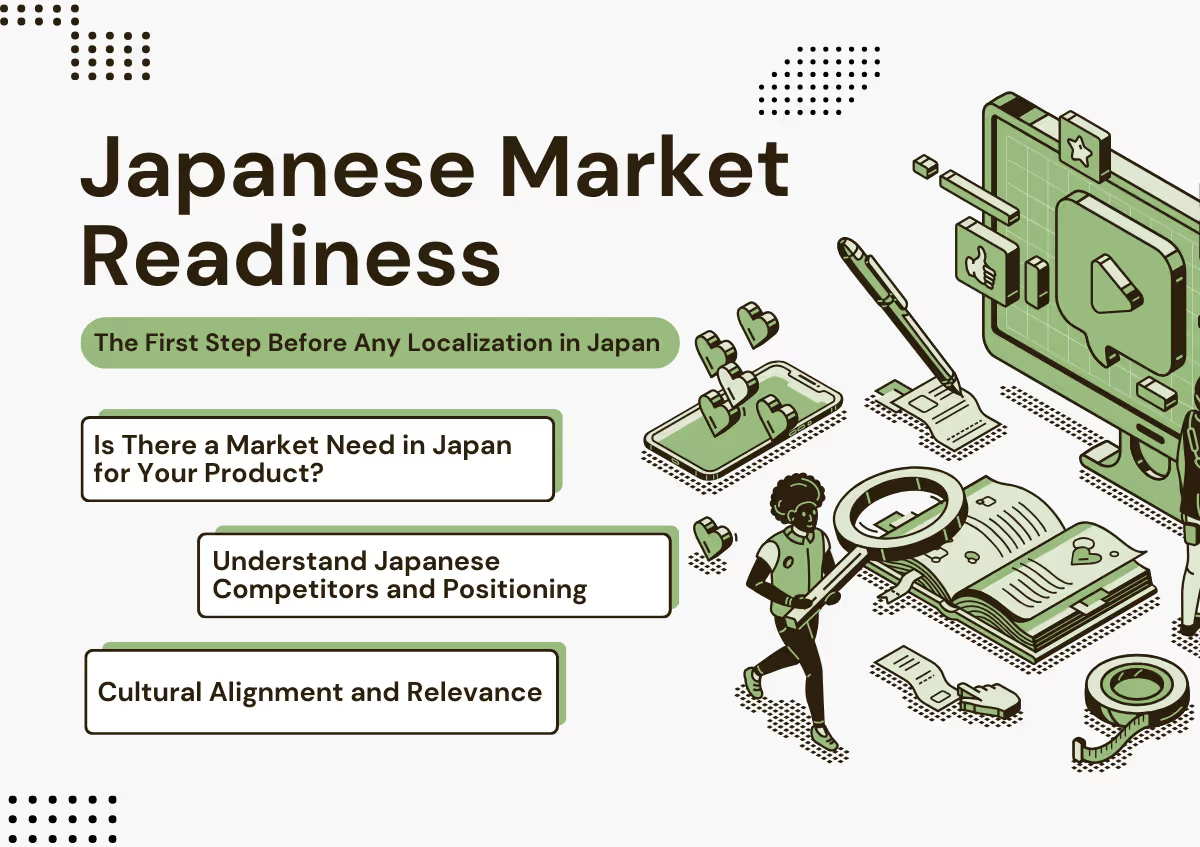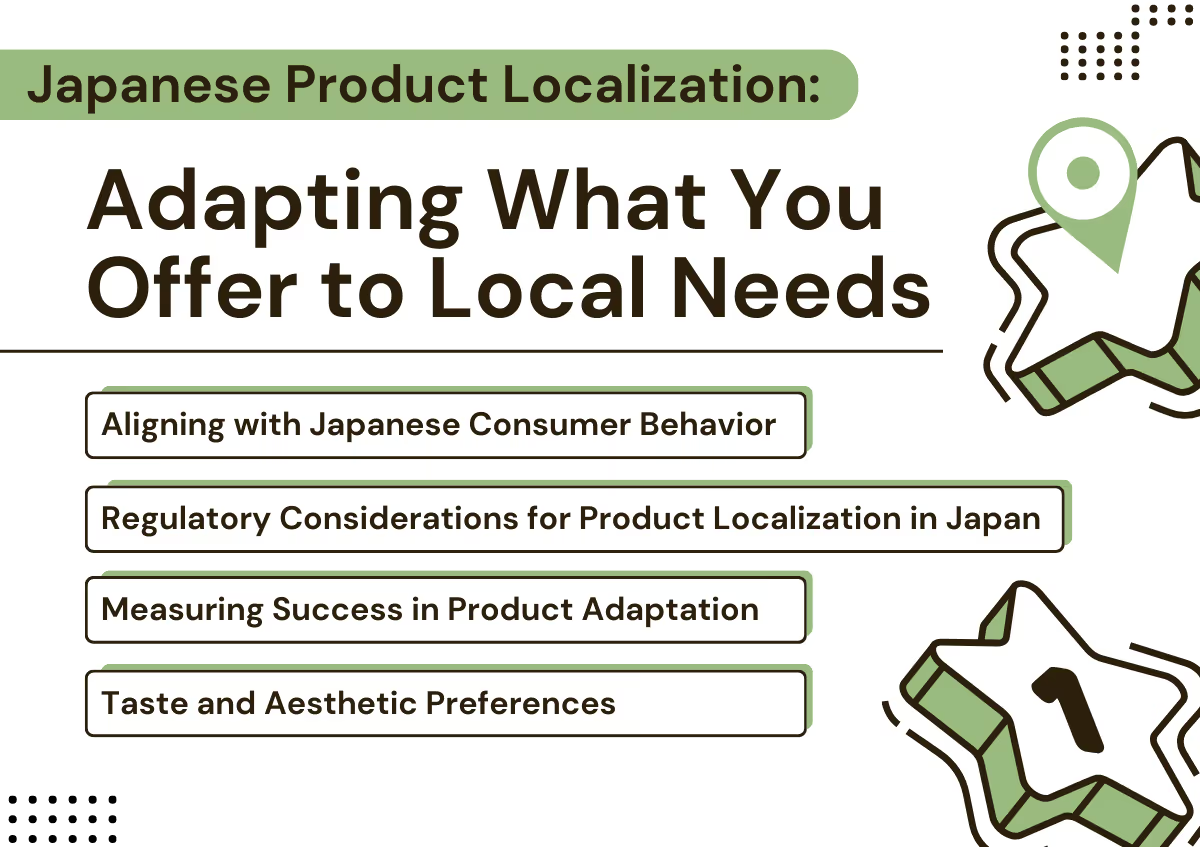Unlocking Success in Japan: The Critical Role of Product and Service Localization

Expanding into Japan represents a significant opportunity, but also one of the most culturally and operationally demanding moves a business can make. While Japan is a global leader in innovation, consumer sophistication, and economic strength, it’s also a market where trust, nuance, and precision define success.
Localization is not simply a matter of translating content—it’s a full-spectrum strategy. From adapting product features to aligning customer service and refining your brand voice, successful Japanese localization means creating a presence that feels native, relevant, and trustworthy.
This article serves as your in-depth guide to understanding what localization in Japan truly entails. Whether you're launching a product, building a service model, or entering Japan’s digital marketing ecosystem, we'll break down the critical components—from market readiness and product adaptation to cultural messaging and platform-specific promotion.
Japanese Market Readiness: The First Step Before Any Localization in Japan

Before you begin the localization process, it’s essential to take a step back and ask the most critical question: Should you even enter the Japanese market?
Localization is a powerful tool, but without product-market fit, no amount of translation, transcreation, or adaptation can compensate for poor alignment. Japan is a lucrative and advanced economy, but it is also highly regulated, culturally distinct, and demanding in terms of quality and service.
This section will help you evaluate your readiness by breaking down three fundamental areas: market demand, competitive positioning, and cultural alignment.
Is There a Market Need in Japan for Your Product?
Before any localization in Japan, your first step is to assess whether the product or service you're offering is actually wanted—and needed—in the Japanese market.
Start by asking:
- Does this product solve a problem for Japanese consumers?
- Are there clear indicators of demand, such as search trends, market reports, or trade data?
- Does it fit within cultural expectations, legal frameworks, and local preferences?
For instance, a dietary supplement that’s successful in the U.S. might face two major issues in Japan:
- Strict regulatory hurdles—Japan's government imposes tight controls on health-related products.
- Limited consumer interest—Japanese buyers may already have trusted domestic alternatives or may prefer natural remedies over pills or powders.
Even if your product has been successful in Western markets, that success does not automatically translate to Japan. Investing in market validation—through consumer testing, focus groups, or even cross-border eCommerce pilots—can prevent costly missteps later.
Understand Japanese Competitors and Positioning
After confirming demand, the next critical step is understanding the competitive landscape in Japan. Localization means very little if you're entering a saturated market or if you can’t position your product clearly against local alternatives.
Ask yourself:
- Who are the top local competitors?
- What are their unique selling propositions (USPs)?
- How do they price, market, and deliver their offerings?
- Where does your product sit in terms of value, quality, or innovation?
Example:
If you're selling a skincare product tailored to anti-aging, you’ll be up against entrenched Japanese brands like Shiseido or Fancl. These companies not only dominate distribution channels but also benefit from deep cultural trust and marketing tailored to Japanese values (e.g., subtlety, safety, ritual). Simply translating your ad campaign and adjusting packaging won’t be enough. You’ll need to define whether you’re offering something truly differentiated—maybe more natural, more tech-forward, or better suited for niche skin types.
At this stage, conducting a SWOT analysis or benchmarking exercise is incredibly useful. Many global companies falter not because they lack a good product, but because they don’t know how to position it effectively within the Japanese market context.
Cultural Alignment and Relevance
Even if your product passes the demand and competition checks, it must still resonate culturally with Japanese consumers. Cultural fit is often the most overlooked barrier in localization for Japan, and it can be the hardest to fix once you're already in the market.
Consider:
- Does the concept or messaging of your product match Japanese values (e.g., group harmony, modesty, precision)?
- Will your product feel “foreign” in a negative way?
- Does the product design, functionality, or even size make sense in Japanese households or lifestyles?
For example, a haircare brand designed for thick, curly hair textures may be irrelevant in Japan, where most consumers have straight or fine hair and seek entirely different performance characteristics. The base product itself, not just the packaging or instructions, would need to be re-engineered to gain traction.
Likewise, products that rely on bold, edgy, or confrontational branding often need to be softened or reimagined entirely. Japanese consumers tend to appreciate polished, respectful, and understated communication.
Understanding this cultural dynamic is critical not just for your marketing team but for product developers, designers, and executive leadership. It will shape how your brand is perceived and whether or not it will be accepted into everyday Japanese life.
Japanese Product Localization: Adapting What You Offer to Local Needs

Japanese consumers expect quality, precision, and usability, and they rarely compromise on any of these. Successfully localizing a product for Japan means more than just translating a manual or adjusting packaging. It often requires rethinking the form factor, features, aesthetics, branding, and even ingredients to meet the expectations of one of the most discerning consumer markets in the world.
Let’s explore the key areas where product adaptation is essential and what best practices can help ensure success.
Aligning with Japanese Consumer Behavior
Japanese consumers are known for their high attention to detail and demand for polish in both physical and digital products. From software interfaces to kitchen appliances, the standard is clear: everything must be intuitive, cleanly designed, and function flawlessly.
What this means for localization:
- User Interfaces (UI/UX): Japanese users often prefer dense, feature-rich interfaces that provide complete information rather than minimal designs. For example, while Western users might appreciate a sleek, minimalist app with hidden menus, Japanese users expect clearly labeled functions, exhaustive help menus, and granular settings.
- Instructions and Documentation: Product manuals, labels, and onboarding materials should be detailed, formatted for easy reference, and written in natural Japanese. Skimping here is seen as lazy or even disrespectful to the customer.
- Product Behavior and Functionality: You may need to adjust how your product functions to reflect local usage habits. For example, appliances in Japan often feature quiet operation modes, multi-step confirmations, or safety-first defaults because these qualities align with cultural norms of politeness, thoroughness, and consideration for others.
Example:
TechPro Innovations, a North American smart home company, miniaturized their devices and enhanced energy efficiency for Japan’s compact urban homes. They also developed a localized app with culturally familiar icons and full Japanese support. The result? 200% YoY growth and recognition as “Best Localized Smart Home Product” in Japan.
Regulatory Considerations for Product Localization in Japan
Japan has a well-deserved reputation for being heavily regulated, especially in product categories that impact public health or safety. These laws are enforced strictly, and non-compliance can result in product bans, fines, or reputational damage.
Which industries need to be extra cautious?
- Health products and supplements: These are under the jurisdiction of the Ministry of Health, Labour and Welfare (MHLW). Health claims must be scientifically verified and pre-approved. Words like “cure” or “prevent” are generally prohibited unless backed by substantial evidence and regulatory review.
- Cosmetics and personal care: Ingredients and labeling must meet Japanese Pharmaceutical and Medical Device Act (PMDA) requirements. Even minor discrepancies in wording can lead to regulatory issues.
- Electronics: Must comply with Japan's Electrical Appliance and Material Safety Law (PSE). Certification and testing through a local agency are often required before a product can be sold.
- Food and beverage: Packaging must include detailed nutritional info, allergen warnings, and proper labeling in Japanese. Many food additives used abroad are not permitted in Japan.
Example:
A U.S. energy drink brand promoting “fat-burning” or “mental sharpness” may face immediate rejection or legal issues in Japan unless it rewords its claims and provides scientific evidence that meets local standards.
Before launching, companies should consult a local regulatory expert or legal advisor to conduct a pre-market review. Failing to do so could derail even the most promising localization efforts.
Taste and Aesthetic Preferences
Even if a product works perfectly and passes all legal hurdles, it must still look, feel, and taste “Japanese.” Cultural aesthetics are deeply ingrained in the buying decision, and a poor fit here can mean rejection at first glance.
What this means for localization:
- Flavors and formats: Japanese palates often prefer subtle, seasonal, and culturally familiar flavors. What works in the U.S. or Europe may not resonate.
- Example: While chocolate and vanilla may dominate Western snack aisles, Japan sees constant success with matcha (green tea), yuzu citrus, black sesame, and sakura (cherry blossom) flavors. Snack giants like KitKat thrive in Japan specifically by offering region-specific and seasonal flavors.
- Visual branding and design: Japanese consumers tend to favor:
- Minimalist design in tech and lifestyle products.
- Kawaii (cute) branding in food, children’s goods, and cosmetics.
- Elegant typography and natural motifs in health or wellness products.
- Naming conventions: Product names may need to be changed to avoid awkward transliterations or unintended connotations in Japanese. What sounds catchy in English might sound strange—or even offensive—when romanized or katakana-ized for the Japanese market.
Example: A skincare brand that uses bold neon colors and edgy fonts in its Western packaging may struggle in Japan, where consumers equate subtle tones and calming design with safety, purity, and quality.
Measuring Success in Product Adaptation
To know whether your localized product is resonating in Japan, you need to track more than just sales. Success is tied to perception, feedback, and strategic growth in the local context.
Key metrics to monitor:
- Sales performance of localized vs. original SKUs
- Market share within the Japanese product category
- Customer satisfaction (reviews, CS tickets, Net Promoter Score)
- Brand perception in Japanese media or user-generated content
- Retailer feedback and reorder frequency
- Social media mentions and engagement on Japanese platforms (e.g., LINE, Twitter/X, Instagram)
- Return on investment (ROI) from adaptation efforts
Product localization in Japan is multi-dimensional. It’s not just about language—it’s about taste, texture, design, regulation, and even emotional resonance. Successful companies treat localization as an opportunity to innovate, developing Japan-exclusive variants, packaging tailored for gifting, and campaigns that celebrate cultural alignment.
Adapt with intent, test with local users, and collaborate with Japanese experts. The payoff? A stronger foothold in one of the world’s most brand-loyal and quality-focused markets.
Japanese Service Localization: Supporting Your Product the Japanese Way

Great products fail in Japan without excellent service—expectations are high.
In Japan, outstanding service isn’t a competitive advantage—it’s the standard. This expectation extends beyond in-store hospitality into every aspect of after-sales support, delivery, and customer interaction.
At the heart of Japanese service culture is the concept of Omotenashi—a deep-rooted philosophy of hospitality that emphasizes anticipating customer needs and delivering exceptional experiences without expecting anything in return. For foreign companies, this means localizing service operations just as thoroughly as products and marketing. Here’s how.
Provide Native-Level Customer Support
In Japan, language proficiency is directly tied to brand trust. A support agent who’s not completely fluent, or customer service that feels "foreign" risks undermining the consumer’s confidence in your product, no matter how good it is.
What it requires:
- Fluent Japanese speakers, preferably native, trained in formal business etiquette (keigo) and local communication norms.
- Responses that reflect respect, attentiveness, and humility, not just solutions. Tone matters as much as content.
- Support is available during Japanese business hours through preferred channels such as phone, email, and LINE.
Example:
If a customer reaches out via phone and encounters a non-native speaker with 80% fluency, it can immediately diminish your credibility, even if the information provided is technically correct. The Japanese consumer may interpret this as a lack of seriousness or professionalism, resulting in dissatisfaction or churn.
Best practices:
- Hire Japanese-speaking customer service agents or outsource to a trusted local agency.
- Provide training on tone, politeness, and escalation etiquette—not just product knowledge.
- Ensure that response times are fast, with acknowledgment within 24 hours or faster on platforms like Rakuten or Amazon Japan.
Match Japanese Expectations for Delivery and Fulfillment
Japan sets the gold standard for logistics. From same-day delivery in Tokyo to precisely timed courier drop-offs, punctuality and precision are non-negotiable. Poor fulfillment erodes customer trust faster than in many other markets.
What Japanese customers expect:
- Fast shipping, with real-time tracking updates and proactive notifications.
- Flawless packaging—damaged boxes or sloppily wrapped items will reflect poorly on your brand.
- Accurate delivery estimates—if you say “two days,” it must be two days.
Example:
In the U.S., a one-day shipping delay might be frustrating. In Japan, the same delay can spark negative reviews, returned orders, or even platform penalties (especially on Rakuten and Amazon). Japanese consumers interpret missed timelines as a failure to uphold the service promise.
Fulfillment best practices:
- Use reliable third-party logistics (3PL) providers familiar with Japanese shipping expectations.
- Consider services like Amazon FBA Japan for e-commerce.
- Test your packaging under Japanese scrutiny—opt for clean, attractive presentation and easy-open designs.
Localizing Support Policies and Warranties
Beyond customer conversations, your support infrastructure—policies, processes, and guarantees—must feel localized. Japanese consumers look for transparency, fairness, and formality in after-sales policies.
What to localize:
- Return and exchange policies: While returns are less common in Japan, when they do happen, consumers expect clear terms, no ambiguity, and respectful handling.
- Warranty information: Ensure warranty periods and claims processes are clearly outlined in natural, respectful Japanese, including clear escalation steps.
- Support channels: Japanese consumers prefer multi-channel access, including traditional touchpoints like telephone and fax, alongside modern options like LINE and email.
Best practices:
- Translate all policies into clear, culturally appropriate Japanese, not just literal translations.
- Offer pre-printed return labels and trackable return options to simplify processes.
- Avoid overly casual language or ambiguous wording. Instead, adopt a tone of formal accountability in all policies and responses.
Service localization in Japan goes far deeper than call center hours or chatbot scripts. It is about earning long-term trust through respect, clarity, precision, and cultural sensitivity. Japanese customers don’t just want a helpful answer—they want it delivered with the right tone, at the right time, by the right person, and wrapped in politeness.
By investing in native-level support, flawless logistics, and localized after-sales care, your company signals that it takes Japan seriously, not just as a market, but as a culture.
Japanese Marketing Localization: Messaging and Channels That Work in Japan

Marketing in Japan requires precision, subtlety, and the right platforms.
Japanese consumers are highly discerning and culturally sensitive, and they expect brand communication to reflect those values. Whether B2C or B2B, success in the Japanese market depends on your ability to earn trust, adapt your tone, and connect through local channels. Translation is only the starting point—effective marketing in Japan requires deep localization of both message and method.
Use the Right Channels
In Japan, success in marketing often hinges on utilizing the right communication tools. Foreign businesses that assume global platforms like WhatsApp or Facebook Messenger will suffice risk missing a significant portion of their target audience.
Key platforms in Japan:
- LINE: Japan’s dominant messaging platform, used not just for personal chat but for brand campaigns, customer support, digital coupons, and eCommerce.
- Twitter (X): Still highly relevant in Japan, especially for fast-paced updates, limited promotions, and public brand conversations.
- Instagram & YouTube: Key platforms for visual branding, influencer collaborations, and lifestyle positioning.
- Rakuten & Amazon Japan: Marketplace presence is critical; marketing often includes product page design, seller communication, and prompt review response.
Example:
Many Japanese businesses run LINE-exclusive campaigns, such as member coupons, seasonal offers, and chat-based customer support. A brand’s absence from LINE could make it seem unfamiliar or inaccessible to local consumers.
Best practices:
- Create a LINE official account and link it to your eCommerce or customer engagement strategy.
- Use influencer marketing on Instagram and YouTube, especially for younger audiences.
- Ensure all marketplace listings are fully localized with clear visuals, polite tone, and professional formatting.
Transcreation: Go Beyond Simple Translation
Transcreation—the art of rewriting content for a different cultural context—is critical in Japan. A direct translation of your Western campaign may miss the mark entirely, either failing to resonate or causing unintended offense.
Cultural dynamics to consider:
- Japanese consumers value group harmony, emotional subtlety, and modesty over individualism or bold claims.
- Humor, symbolism, and idiomatic expressions often don’t translate literally and must be reinterpreted through a local lens.
- Taglines and slogans need to be emotionally relevant, not just linguistically accurate.
Example:
A U.S. ad campaign built around the theme of “freedom” may not perform well in Japan, where themes like “belonging,” “trust,” or “effort” are more emotionally powerful. Instead, the same message might be adapted to emphasize working together, inner strength, or community success.
Case in point: KitKat’s success in Japan was significantly boosted by a transcreation that turned its name into a good-luck pun ("Kitto Katsu"), connecting it to exam season gift-giving culture. That local emotional hook helped the brand dominate Japan’s chocolate market.
Tips for transcreation:
- Hire copywriters or brand strategists fluent in Japanese culture, not just language.
- Tailor each campaign to local values, events, and emotional tones.
- Regularly test messages with native-speaking focus groups to validate resonance.
Cultural Nuance and Tone
In Japan, how you say something matters just as much—if not more—than what you're saying. Marketing messages should be formal, polished, and emotionally appropriate. Even minor missteps in tone or formality can significantly damage brand perception.
Avoid:
- Overly bold or brash claims
- Sarcasm, humor based on irony, or irreverent language
- Informal or casual expressions in professional materials
Embrace:
- Respectful tone using honorifics where appropriate
- Clean, minimal, and aesthetically refined visuals
- Emotional messaging that focuses on shared values, relationships, and reliability
Example:
In B2B, trust and credibility are paramount. Campaigns should focus on long-term value, consistency, and respect, rather than short-term pricing advantages. For consumer brands, tone down exaggerated claims and focus on storytelling, tradition, and connection.
Visuals also matter. Consider cultural symbols, color psychology (e.g., red and gold for celebration, white for cleanliness), and seasonal design motifs. Brands like Coca-Cola and McDonald’s Japan excel here, with limited-edition cherry blossom packaging in spring and seasonal flavors like sakura mochi pie.
Challenges in Localizing for Japan

Japan is one of the most attractive yet complex markets for global companies. While its economy is large, stable, and highly developed, localizing for Japan is uniquely challenging. Success requires more than linguistic accuracy—it demands deep cultural understanding, strategic investment, and adaptation at every level, from software to packaging, from UI design to brand messaging.
Let’s explore the key localization challenges businesses face when entering the Japanese market.
Linguistic Complexity and Script Challenges
Japanese is one of the most challenging languages to localize accurately. It employs three different writing systems—kanji, hiragana, and katakana—each with specific use cases, formality levels, and visual implications.
Key issues include:
- Honorific language (keigo): Critical for customer-facing content, but challenging to get right unless you're fluent in social hierarchy and nuance.
- Text expansion/contraction: Japanese text often requires more space than English or vice versa, affecting UI/UX layout, especially in software, mobile apps, and games.
- Multiple meanings: Kanji can have multiple readings, and subtle changes can significantly alter tone and definition.
- Terminology accuracy: Especially in technical, legal, or branded contexts, precise terminology is crucial. A wrong word can damage credibility or lead to misunderstandings.
- Literal translation pitfalls: Direct translations often miss cultural context, leading to awkward phrasing or messages that fall flat.
Solution:
Employ professional translators and native linguists who specialize in transcreation and industry-specific terminology, and conduct UX testing with Japanese users.
Cultural Sensitivity and Communication Norms
Japanese culture is characterized as high-context, formal, and deeply nuanced. Localization efforts must extend far beyond language to align with cultural expectations and communication styles.
Challenges include:
- Avoiding offense: Cultural taboos, inappropriate symbols, or overly casual language can alienate users. Colors, imagery, and metaphors all carry specific meanings in Japan.
- Marketing tone: Japanese marketing avoids aggressive or boastful language. Politeness, modesty, and harmony are more effective than bold, Western-style messaging.
- Design preferences: Unlike Western minimalism, Japanese consumers often prefer densely packed information, particularly in product descriptions, ads, and interfaces.
- Regional variation: Cultural and linguistic differences between Tokyo, Osaka, Hokkaido, and Okinawa can influence how content is received. A one-size-fits-all approach may not be practical nationwide.
Solution:
Conduct thorough cultural reviews of all assets, work with local experts, and consider regional segmentation in your marketing or sales strategy.
Regulatory and Legal Requirements
Japan has strict laws and compliance standards, particularly in areas like health, tech, e-commerce, and data privacy.
Key challenges:
- Product safety and labeling: Requirements vary by industry and often require pre-market approval, especially in food, cosmetics, and electronics.
- Data privacy and digital compliance: Japan’s Act on the Protection of Personal Information (APPI) enforces strict data handling protocols.
- E-Commerce regulations: Selling on platforms like Rakuten or Amazon Japan requires adherence to specific seller rules and documentation standards.
Solution:
Partner with local legal advisors and regulatory consultants to ensure all your content, processes, and products comply with Japanese law.
Maintaining Brand Identity While Localizing
One of the most significant strategic hurdles is preserving your brand’s global essence while localizing enough to feel authentically Japanese.
Tensions include:
- Over-localizing to the point that the brand loses its global voice
- Under-localizing and appearing foreign, out of touch, or tone-deaf
- Adjusting visuals, slogans, or product names without compromising core identity
Solution:
Create a Japan-specific brand strategy that defines how global values translate into local messaging. Use flexible brand guidelines that allow for adaptation without fragmentation.
Cost, Time, and Operational Complexity
Effective localization for Japan demands substantial investment in time, resources, and strategic planning.
Challenges include:
- Upfront costs for translation, cultural adaptation, regulatory compliance, and testing
- Longer timelines due to multiple review rounds, legal processes, and iteration cycles
- Staffing needs, including bilingual project managers, native customer support, and localization QA specialists
Solution:
Prioritize localization efforts based on market potential and ROI, and consider a phased rollout of product lines or services. Use a local partner network to reduce internal overhead.
Market Competition and High Consumer Standards
The Japanese market is saturated with high-quality domestic and foreign brands. Consumers are loyal, but extremely discerning, and they expect excellence in every detail, from grammar to customer service tone.
Other complications:
- Limited English proficiency among local partners or consumers may create communication barriers for foreign staff.
- Standing out requires more than just novelty—it requires flawless execution, trusted service, and long-term relationship building.
Solution:
Invest in local hiring, consumer research, and long-term trust-building strategies. Don’t rely on brand novelty alone—demonstrate reliability and cultural fluency.
Conclusion: Embrace Japan Localization to Build a Lasting Presence

Succeeding in Japan is not about quick wins or simple adaptation. It’s about deep alignment with one of the world’s most culturally rich and customer-focused markets. Businesses that thrive here understand that localization is a strategic commitment, not a checkbox. They invest in language accuracy, emotional relevance, regulatory readiness, and consumer empathy.
Localization isn’t about changing who you are—it’s about respectfully evolving your brand to fit into Japan’s cultural fabric without losing your core identity. And when that’s done well, the reward is lasting: brand equity, loyal customers, and sustainable growth in a region that values depth over hype.
Key Takeaways: Japanese Localization Essentials
- Start with Market Fit: Don’t localize before validating that your product or service meets real demand in Japan. Market research, competitor benchmarking, and cultural relevance are your foundation.
- Product Must Evolve, Not Just Translate: Japanese consumers expect quality, customization, and attention to detail. Localizing your product often means rethinking UI, functionality, packaging, and even ingredients.
- Service Is Brand: Omotenashi—the Japanese spirit of hospitality—demands service that is fast, respectful, and highly personalized. Fluent support, localized return policies, and flawless delivery are non-negotiables.
- Marketing Needs Cultural Precision: From using LINE instead of WhatsApp to transcreating messages for emotional alignment, success depends on meeting Japan’s high standards for tone, messaging, and platform strategy.
- Localization is a Long-Term Strategy: It requires upfront investment, but when done correctly, it unlocks long-term brand trust, differentiation in a saturated market, and real business growth.
Ready to Localize for Japan? IGNITE Is Your Partner on the Ground

At IGNITE, we don’t just help you translate—we help you thrive.
As a team of multilingual Japanese and foreign digital marketing specialists based in Osaka, we serve as your local marketing division, not an agency you outsource to, but a partner you integrate with. From market research and strategy to translation, content creation, advertising, and full-scale digital campaigns, we help you localize, scale, and succeed.
We specialize in:
- Localized SEO and SEM strategies
- Cultural transcreation of digital content
- High-performance ad campaigns
- UI/UX and web development optimized for Japanese audiences
- Bilingual customer support systems
- Project and business planning for market entry
Whether you're just entering the Japanese market or ready to scale, IGNITE is here to bridge the language, cultural, and strategic gaps—with speed, quality, and clarity.
Let’s IGNITE your brand in Japan.
Contact us for a consultation and market localization strategy tailored to your business.














